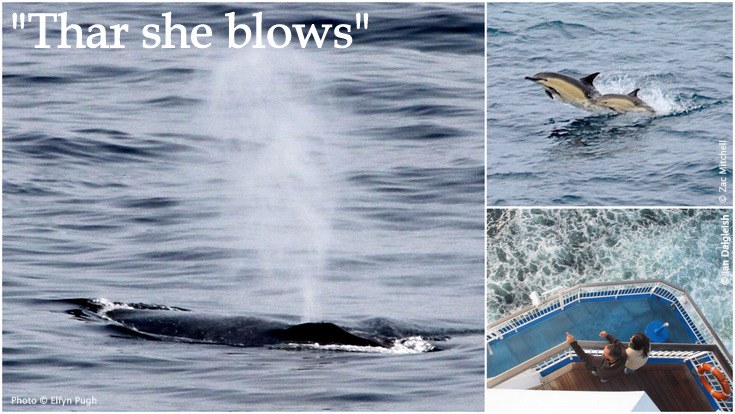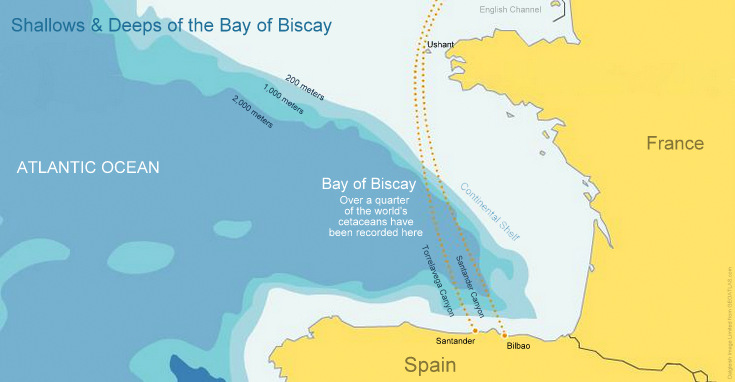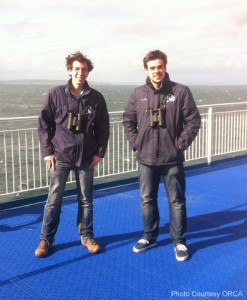Biscay Whale Watching with Brittany Ferries
A friend was travelling from Britain to Spain with Brittany Ferries.
“You might see a whale”, I said.
“Really?” she queried, not quite believing.
“Yes, really”.
When you think of whale and dolphin hot spots the Bay of Biscay on Europe’s doorstep doesn’t spring to mind, yet over a quarter of the world’s cetacean species (whales, dolphins and porpoises) have been recorded here. Travel to northern Spain on one of Brittany Ferries regular routes from Portsmouth or Plymouth and there’s a chance, if you keep a good look-out, of seeing bow riding dolphins, the tall, straight blow of a Fin Whale – it’s the second largest whale on earth, or even having your own Moby Dick moment watching the tail flukes of a Sperm Whale slide beneath the waves.
Of the dolphins, gregarious and acrobatic common and striped dolphins are the most likely to be seen porpoising over the water, sometimes together in mixed groups. Moving up in size, bottlenose dolphins are another species regularly sighted, as are mis-named pilot whales – they’re actually dolphins named in the belief that groups or pods of whales had their own leader or ‘pilot’. Mid Summer, July into September, is the best time for seeing the bigger cetaceans like fin and sei whales, when they come into the Bay to feed.
Last year a special whale watching mini cruise run by Brittany Ferries in conjunction with the cetacean charity ORCA delivered a once in a lifetime moment with the sighting of a blue whale, the largest creature on our planet.
Brittany Ferries and ORCA have teamed up again this year to help passengers experience whales and dolphins in the wild with wildlife officers in residence aboard luxury ferry Cap Finistère and six themed wildlife watching mini cruises taking place aboard flagship Pont Aven over the summer. Sharing their enthusiasm and knowledge is ORCA’s way of protecting these magnificent animals.
So what is it about the Bay of Biscay that makes it a key site for cetaceans? Sally Hamilton, Director at ORCA explained the answer lies in the underwater topography which includes the relatively shallow waters of the continental shelf (we’re talking up to 200 meters), the sharp descent of the shelf edge into oceanic waters up to 4000 m deep and off the northern Spanish coast deep submarine canyons where giant squid lurk. Some toothed whales like the sperm whale are known to brave these eight armed monsters for a meal. Fin whales and pilot whales, meanwhile are often found in the vicinity of the shelf edge where nutrient rich waters well up providing food for smaller creatures like shrimps which in turn provide food for other creatures all the way up the food chain to whales and dolphins.
Meet ORCA’s wildlife officers aboard Cap Finistère
ORCA’s wildlife officers take it in turns to do two week stints on-board. I spoke to Zac who had just come off a run on Cap Finistère and started by asking if it had been a good trip for sightings. It had, he said, besides a fantastic sunset the highlights being a pod of around 100 common dolphins and a pod of pilot whales that had come close to the ship.
From the moment the lines are cast off you might see something special. In the Channel the most likely sightings are of harbour porpoises – the smallest species found in our waters at up to 2 metres in length, and Minke Whales, while from above the vertical plunges of gannets can be spectacular. Around Ushant and into the Bay of Biscay though is where the real concentrations of wildlife are to be seen and Zac and his fellow officers try to spend as many daylight hours as possible on deck scouring the seas. A read through their blog brings not just cetacean sightings but sea birds on the wing, jelly fish, sharks and exotic sounding ocean sunfish.
Where, what, when and how many are the vital facts to record. Once a creature is spotted the position is noted from the GPS the officers carry, its species code recorded and an estimate made of number. The next job is to get photos which can help with identification. Zac uses a 70mm- 300mm telephoto lens which seems to cater for most situations.
How was it best to go about spotting whales and dolphins I wondered? Zac explained they take a side of the deck and make 180 degree sweeps, being systematic is the key; moving from side to side you are more likely miss things. Adding the ship’s officers on the bridge with an all round view helped out by giving a shout if they see anything.
Spotting creatures at sea is a bit like seeing hidden objects in a picture, it’s a question of getting your eye in and knowing what you are looking for. Once you’ve made a few sightings it’s easier to see more. Flat sea conditions help of course.
This is where the presentations Zac and his fellow wildlife officers give on each trip come in handy, after an introduction to cetaceans as a group they take passengers through the species they’re likely to see and what to look out for – size, fin shape, blow…. Presentations take place in the mezzanine area at the stern of the ship with views over the sea through picture windows – it’s not unknown, I’m told, for the stars of the show to appear on cue just as they’re being introduced.
And the most exciting sighting on his watches? A difficult one. Zac picked out the sightings of Fin Whales as this is a group whose movements little is known about, also the sighting of a beaked whale. Glimpses of these funky looking whales which live at depth are not so common. Zac didn’t actually spot this one himself as he was setting up a presentation but luckily a passenger captured it on camera & brought it along to be identified.
Wildlife Watching in Cruise Ship Style
If you fancy a more in depth wildlife watching experience with a touch of luxury and a flavour of Spain, then one of the mini cruises around the Biscay triangle, Portsmouth -Santander – Plymouth is the answer.
What is certain is that you won’t find many whale watching boats as big and stylish as the Pont Aven. With three restaurants, dishes freshly prepared by French chefs, a choice of bars and a spa – just a few of the attractions, it might be a struggle to tear yourself away onto deck.
Add to this the sight of the Picos Mountains rising above the Spanish coastline, the run in along the beautiful Santander estuary and time to nip ashore for a cerveza and tapas. However you look at it, crossing the wildlife rich waters of the Bay of Biscay with Brittany Ferries is a trip to be savoured.
Striped (left) & Common dolphins
A Special Moment
I was on my way back to the cabin, one more look out through the full glass sided windows as the daylight began to fade.
A darker patch of grey in the waves, had I seen something?
Then again moving, more definite – a whale.
I saw it again a couple more times then it was gone.
There was just one other person nearby.
“Did you see it?”, he asked, eyes alight
We turned back to stare into the waves, united for a moment in the wonder of the sight we’d just seen.
Photos courtesy ORCA Copyright as credited
Diane Dalgleish
If you would like to know more about ORCA’s work and for information on becoming a volunteer please click here
Have you seen a whales or dolphins in the wild – from shore or boat? Do let us know.



